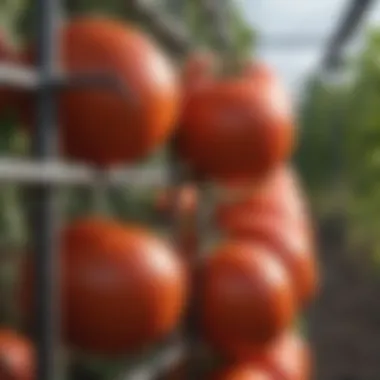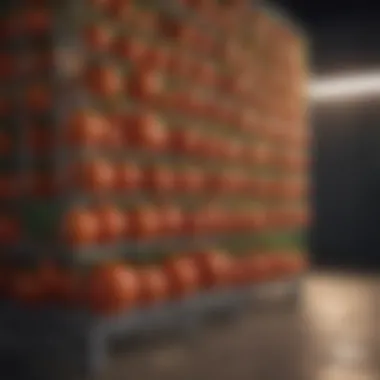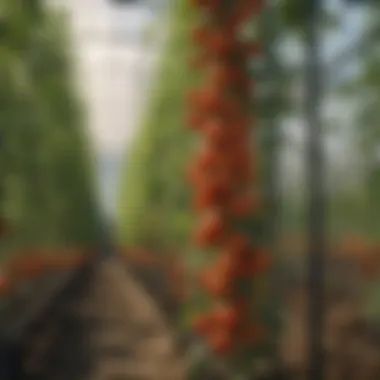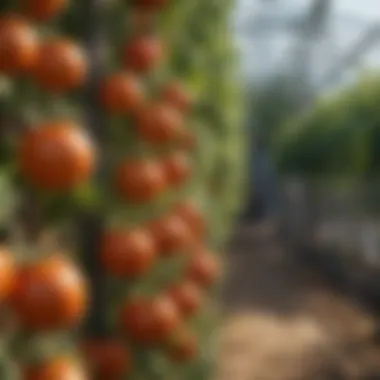Expandable Tomato Cages: Design and Benefits for Gardeners


Intro
Expandable tomato cages are essential structures for supporting tomato plants as they grow. Many gardeners, both novice and experienced, often encounter challenges in ensuring their tomato plants remain healthy and productive. A well-designed tomato cage provides the necessary support, preventing sprawling growth and encouraging upright development. This guide delves into the intricate details of expandable tomato cages—from their construction materials to practical applications. By the end, readers will gain a clear understanding of how to effectively select and utilize these tools in their gardening efforts.
Topic Overview
Definition of Key Terms
- Tomato Cage: A support structure designed to hold tomato plants upright, enhancing air circulation and sunlight exposure.
- Expandable Design: Features that allow the cage to increase in height or width, accommodating the plant's growth.
- Stability: Refers to the strength and robustness of the cage in providing support to the plants.
Relevance in Agriculture, Horticulture, and Agronomy
Expandable tomato cages significantly contribute to the agricultural practices surrounding tomato cultivation. For gardeners, these cages provide necessary support, ensuring optimal sunlight and nutrient distribution. Moreover, they prevent potential diseases that result from foliage contact with damp soil. In commercial horticulture, using these cages enables more efficient harvesting and enhances overall tomato quality, benefiting both growers and consumers alike.
Current Trends and Innovations
Recent Advancements in the Field
The development of materials used for expandable tomato cages has evolved considerably. Traditional metal cages now compete with lightweight plastics and composite materials that offer durability and flexibility, making them easier to handle and store. Additionally, the designs have been optimized for better user experience, with collapsible features that simplify assembly and disassembly.
Emerging Technologies and Practices
As technology advances, so do the practices surrounding the gardening community. Smart gardening tools, which can monitor plant health and moisture levels, are becoming more prevalent. Integrating these tools with expandable cages allows gardeners to optimize support strategies based on real-time plant needs. Furthermore, the rise of vertical gardening continues to influence the design of plant supports, including tomato cages, promoting efficient use of space in limited environments.
Practical Applications
Step-by-Step Guides or How-Tos
Building a sturdy and functional expandable tomato cage can be accomplished with the right approach. Here’s a simple guide:
- Select the Right Material: Choose between metal, wood, or durable plastic based on your preferences and local availability.
- Measure the Height and Width: Ensure the cage is appropriately sized for the expected height of the tomato plants.
- Create the Cage Structure: For a metal cage, cut wires to the desired lengths and form a cylindrical shape. If using wood, secure the pieces to forming a square or rectangular shape.
- Add Expandability: Integrate elements like adjustable height sections or collapsible components to allow for growth.
- Secure the Base: Drive stakes or anchors into the ground to stabilize the cage under windy conditions.
Tips and Best Practices for Implementation
- Choose the Right Location: Position the cage in a spot that receives sufficient sunlight.
- Monitor Plant Growth: Regularly check the need for adjustments as the plant matures.
- Use Additional Supports: Consider using twine or clips to further secure branches as they grow heavy with fruit.
"A well-constructed cage not only supports growth but also enhances the overall health of the tomato plant."
Prologue to Expandable Tomato Cages
Expandable tomato cages are crucial components in the successful cultivation of tomato plants, particularly for gardeners who seek to maximize their yield while maintaining plant health. These structures provide essential support, enabling plants to grow vertically and reducing the risk of damage caused by heavy fruit. Understanding how these cages function can significantly impact the growth and productivity of tomato plants.
What are Expandable Tomato Cages?
Expandable tomato cages are specifically designed to support tomato plants during their growth cycle. Unlike traditional fixed cages, these cages are adjustable, allowing for expansion as the plants grow taller and more robust. They are typically constructed from durable materials such as metal, plastic, or wood, and often feature a design that enables easy assembly and disassembly. The main purpose is to keep the tomato plants upright, prevent them from sprawling on the ground, and facilitate proper air circulation among the plant's foliage.
These cages can vary in size and shape. Some may be circular, providing a broad base for stability, while others are square for ease of stacking and storage. They often come equipped with hooks or clips to secure the plants effectively as they grow. This adaptability is what makes expandable tomato cages a preferred choice for gardeners.


Importance of Supporting Tomato Plants
Supporting tomato plants is imperative for various reasons. First, it helps to keep the fruits off the ground, which significantly decreases their exposure to soil-borne diseases that can affect their health and yield. When tomatoes lie on the soil, they are prone to rot and pest infestations, which can result in a poor harvest.
Furthermore, proper support enhances sunlight penetration and air circulation around the plants. Good air movement reduces humidity levels close to the leaves, which minimizes the risk of fungal infections. When the foliage is well-ventilated, nutrients are more effectively distributed, contributing to healthier plant growth.
In addition, supporting the plants makes harvesting easier and more efficient. Gardeners spend less time searching for ripe tomatoes hidden beneath leaves or on the ground. With the plants elevated, it is simpler to spot and pick fruit, thereby ensuring the entire crop is utilized.
"The right support structure contributes significantly to the health and productivity of tomato plants, making expandable tomato cages an essential tool in modern gardening."
Design and Features
The design of expandable tomato cages significantly influences their effectiveness in supporting tomato plants. Various features enhance their functionality, allowing for tailored solutions that meet the diverse needs of gardeners. Understanding these designs is crucial as it helps in choosing a suitable cage that promotes robust plant growth, facilitating both the health of the plants and ease of maintenance for the gardener. Different materials, shapes, and height options can affect a cage’s durability, ease of use, and the amount of support it provides.
Materials Used in Construction
Metal
Metal is a common choice for tomato cages due to its strength and durability. Cages made from metal can withstand heavy winds and provide substantial support for tomato plants as they grow. The key characteristic of metal is its resilience, which ensures long-lasting use through various weather conditions. A unique feature of metal tomato cages is the ability to easily secure them into the ground, preventing tipping over. However, their weight can make them cumbersome to move, and they may be prone to rust if not treated properly, which is a downside for some gardeners.
Plastic
Plastic tomato cages are often lightweight and easy to handle, making them a popular choice for many gardeners. The flexibility of plastic allows for various designs, including colorful options that can add visual appeal to a garden. A key characteristic of plastic is its resistance to rot and corrosion, meaning it can remain useful for many seasons. The major advantage is that plastic cages do not require significant maintenance and can be easily transported. On the other hand, their lightweight nature may lead to stability issues during storms or heavy rains, causing potential challenges in windy areas.
Wood
Wooden tomato cages provide a natural and aesthetically pleasing option for gardeners. The key attribute of wood is its sustainability, as it can blend seamlessly into a traditional garden setting. Wooden structures offer considerable support, especially if built with thicker materials. A unique feature of wood is that it can be customized in terms of height and design, allowing gardeners to match their specific needs. Nevertheless, wood can be susceptible to rot over time and may require regular treatment to maintain its integrity, which should be a consideration for users.
Variety of Designs Available
Round Cages
Round cages are one of the most popular designs for supporting tomato plants. Their circular shape allows for 360-degree access to the plants, making them ideal for sprawling vine growth. The key characteristic of round cages is their ability to provide multi-directional support, which promotes healthy plant structure. One advantage is their convenience in accommodating a variety of tomato types, especially indeterminate varieties that continue to grow throughout the season. However, they can be less stable compared to other shapes if not properly anchored.
Square Cages
Square cages offer a different level of support and can be beneficial for gardeners looking for an efficient way to maximize space. The edges of square cages provide a distinct support system that can help stabilize wider plants. A key feature of square cages is their stackability and modular design, allowing for easy storage and adjustment as plants grow. These cages may be ideal for defined garden spaces, but they can sometimes restrict plant growth if the dimensions are too narrow.
Collapsible Structures
Collapsible tomato cages provide the advantage of easy storage when not in use. This design is particularly useful for gardeners with limited space, allowing for compact storage during the off-season. The key advantage is their portability, enabling quick setup and take-down when necessary. These structures can be made from various materials, including metal and plastic, accommodating different preferences. However, their lightweight design can compromise sturdiness, especially during adverse weather conditions, which is a factor gardeners should keep in mind.
Height and Expandability Features
Height and expandability are critical features in the effectiveness of tomato cages. Many designs allow users to adjust height according to their specific plants’ growth or garden layout. Expandability means that as plants grow taller, the cages can be expanded to provide continued support. This adaptability ensures that gardeners can meet the changing needs of their plants throughout the growing season, ultimately leading to healthier plants and a more productive harvest. Understanding these features helps in making informed decisions when purchasing tomato cages.
Assembly and Installation
The assembly and installation of expandable tomato cages is a crucial component that can greatly impact the success of growing tomatoes. This phase requires careful consideration to maximize both stability and effectiveness. A well-assembled cage not only supports the tomato plant but also facilitates air circulation and makes maintenance easier. Understanding how to properly assemble and install these structures ensures that the plants are secure and given the best chance to thrive.


Step-by-Step Assembly Instructions
Assembling an expandable tomato cage can seem daunting, but following clear, concise steps makes it manageable. Below is a straightforward guide to help you through the process:
- Gather Materials. Ensure you have all components for your cage. This often includes the cage frame, connectors, and any necessary tools like pliers or a hammer.
- Lay Out the Frame. Before starting assembly, lay out all parts on a flat surface. This will help you understand how pieces connect and avoid confusion during assembly.
- Connect the Sections. Start with the base. Attach the vertical sections using connectors. It's important to secure them tightly to prevent wobbling.
- Attach Horizontal Supports. Next, add horizontal supports if your design includes them. These will help distribute weight and provide additional stability.
- Expand the Cage. If the cage is expandable, adjust it to your desired height. Ensure that all expandable parts lock in place to maintain stability.
- Secure to the Ground. Once assembled, place the cage into the ground. You may need to press down firmly or use a mallet to ensure it penetrates the soil enough for stability.
- Check Stability. Finally, check if the cage stands firm. Adjust as needed before introducing the tomato plants.
By following these steps, gardeners can create a solid framework to support tomato plants throughout their growth cycle.
Best Practices for Installing Tomato Cages
Successfully installing tomato cages is just as important as assembling them. Here are several best practices that can help ensure effective plant support:
- Timing of Installation: Install the cages early in the growing season when the plants are young. This prevents root damage later.
- Proper Depth: Bury the cage at least a foot into the ground. This enhances wind resistance and prevents tipping during storms.
- Orientation Matters: Position the cages to maximize sunlight exposure. This promotes even growth and healthier plants.
- Spacing Between Cages: Maintain adequate distance between cages to allow for air circulation and ease of access during maintenance.
- Monitor After Installation: Keep a regular check on the stability of the cage as plants grow. Adjustments may be needed if the plant becomes heavy or the cage starts to lean.
Implementing these best practices ensures that both the assembly and installation of expandable tomato cages meet the requirements for optimal growth and support, leading to healthier tomato plants and a more fruitful harvest.
"An investment in proper assembly and installation of tomato cages pays dividends in the form of healthier plants and better yields."
By focusing on these aspects, gardeners can effectively utilize their expandable tomato cages, enhancing their gardening efforts significantly.
Benefits of Using Expandable Tomato Cages
Expandable tomato cages are a valuable tool for both novice and experienced gardeners. They offer a range of benefits that enhance plant growth and simplify maintenance tasks. Exploring these benefits can help gardeners understand the importance of selecting and utilizing these structures effectively.
Enhanced Plant Support
One of the primary advantages of using expandable tomato cages is the enhanced support they provide to the plants. As tomato plants grow, they can become heavy with fruit and foliage. Without adequate support, the stems may break or bend, leading to poor growth or even plant death. Expandable cages are designed to accommodate the growing plants, allowing them to flourish upward instead of sprawling on the ground. This vertical growth not only supports the plant structurally but also encourages more robust fruit development. The sturdy design prevents plants from leaning over and maintains their shape.
Improved Air Circulation
Good air circulation is essential for healthy plant growth. When plants are allowed to grow freely in an organized manner, air can flow more easily around them. Expandable tomato cages create space between the plants, which reduces moisture buildup and minimizes the risk of fungal diseases. When plants are crowded, air doesn’t flow effectively, leading to damp conditions that can attract pathogens. By using expandable cages, gardeners can facilitate better ventilation and, in turn, promote healthier plants.
Facilitates Maintenance and Harvesting
Maintaining tomato plants can be labor-intensive. Expandable cages simplify this process considerably. With plants contained within a cage, tasks like watering, pruning, and harvesting become easier. Rather than searching through tangled vines, gardeners can access the plants directly. When it comes time to harvest, the fruits are more visible and reachable. This accessibility encourages regular inspections, fostering a habit that helps in identifying potential issues early.
Gardening becomes less daunting when tools make hands-on tasks more manageable. By integrating expandable tomato cages into their gardening practices, enthusiasts can enjoy a more productive harvest with less effort.
The key to successful tomato cultivation lies in supporting plants correctly and facilitating care, making expandable cages a practical choice.
Challenges and Considerations
Understanding the challenges and considerations regarding expandable tomato cages is essential for gardeners who aim to provide adequate support for their plants. These factors can influence the effectiveness and longevity of the cages. Thus, knowing how to address these challenges ensures a fruitful growing season.
Durability and Weather Resistance
Durability plays a crucial role in the choice of materials for expandbale tomato cages. The cage must withstand various elements such as rain, wind, and intense sunlight. Material selection impacts weather resistance. For example, metal cages are often more durable compared to plastic ones. Types like galvanized steel or powder-coated metal can resist rust and other forms of corrosion. They provide a sturdy option for long-term use.
- Plastic cages can be lightweight but may not hold up well in extreme weather, leading to rapid wear.
- Wooden cages, while attractive, can rot if not treated properly. They may require regular maintenance to extend their lifespan.


Investing in quality materials will pay off in the long run. A durable cage supports healthy plant growth throughout the season. Regular inspections can help gardeners identify any signs of wear or damage, ensuring timely repairs or replacements.
"Durability is not just about the materials; it’s about making informed choices that support long-term growth."
Potential Stability Issues
Another critical consideration is stability. Expandable tomato cages must be stable enough to support tall, sprawling tomato plants. Poor stability can lead to plants falling over, resulting in broken stems and damaged fruit. Factors affecting stability include soil type, depth of installation, and the design of the cage itself.
- Soil Type: Sandy soil may not provide enough grip for the cage, leading to wobbly structures. In contrast, clay soil offers better support but can become compact and heavy when wet.
- Installation Depth: Properly anchoring the cage deep into the ground improves stability. A deeper installation reduces the risk of toppling under pressure from vigorous plant growth.
- Design Considerations: Some designs may be more prone to tipping than others. Opting for broader base designs enhances stability.
To combat potential stability issues, it's beneficial to consider using stakes or anchors. These can provide additional support and ensure that the cages remain upright. Regular assessments help to maintain stability throughout the growing season.
By addressing these challenges, gardeners can significantly enhance the performance of their expandable tomato cages, thereby supporting healthy tomato plants and maximizing yields.
Maintenance and Care
The maintenance and care of expandable tomato cages play a vital role in ensuring their effectiveness and longevity. Regular upkeep is not just about preserving the physical structure but also enhancing the overall health of the plants they support. By focusing on maintenance, gardeners can avoid potential pitfalls that may arise from neglect. This section delves into essential practices that can help sustain both the cages and the plants they protect.
Regular Inspections
Conducting regular inspections of your expandable tomato cages is crucial. Ideally, these inspections should be performed at the beginning of each growing season and periodically throughout. Look for signs of wear or damage, such as rust on metal cages or cracks in plastic structures. Early detection allows for timely repairs, preventing more significant problems later.
Some specific aspects to check during inspections include:
- Structural integrity: Ensure that joints and connections are secure. This helps maintain stability as the plants grow heavier.
- Surface conditions: Watch for any corrosion or wear. Metal cages, in particular, may be prone to rust if exposed to moisture.
- Alignment and positioning: Cages should be upright and positioned correctly to provide adequate support to the plants.
By incorporating this practice into your routine, you can extend the life of your tomato cages and enhance their performance.
Repairing Damaged Structures
Repairing damaged structures is an essential part of maintaining your expandable tomato cages. Regular inspections often reveal minor issues that, if addressed promptly, can save the cost of replacement. The method of repair will depend on the material of the cage.
For metal cages, rust spots should be treated immediately. A simple method involves using sandpaper to remove the rust, followed by applying a rust-inhibiting paint. This prevents further corrosion and maintains the cage’s strength.
Plastic cages may develop cracks or brittleness from UV exposure. In these cases, consider using a strong adhesive or plastic weld to fix small cracks. If the damage is extensive, replacement might be the best solution, as the integrity of the support is critical.
Key points for effective repairs:
- Materials at hand: Keep repair materials handy and appropriate for the type of cage.
- Timely action: Address minor damages as soon as they are noticed.
"Regular maintenance, including inspections and repairs, preserves the functionality of tomato cages, significantly impacting plant growth and yield."
The End
The conclusion section of this article serves as a synthesis of the essential aspects concerning expandable tomato cages. This is a critical element as it consolidates the information discussed, providing a clear understanding of how these structures can elevate gardening practices. Moreover, a well-structured conclusion reinforces the significance of the main topics explored, guiding readers to reflect on the benefits and practical considerations surrounding the use of expandable tomato cages.
Final Thoughts on Expandable Tomato Cages
Expandable tomato cages offer several advantages that can significantly contribute to the success of tomato cultivation. They enhance plant support, allowing for proper growth and preventing damage to weak stems. This support is vital to ensure that the plants can thrive without being burdened by their fruit, which often leads to breakage.
Moreover, these cages promote better air circulation around the plants. Proper airflow is crucial to minimize the risk of fungal diseases and pests that can plague dense foliage. By utilizing expandable cages, gardeners can create an optimal environment for their tomato plants, ultimately leading to healthier yields.
However, the choice of expandable tomato cages should not be made lightly. Considerations like material durability, weather resistance, and stability should be top of mind. By paying attention to these factors, gardeners can ensure that they invest in reliable structures that support their plants effectively.
In summary, a thoughtful approach to selecting and using expandable tomato cages can make a significant difference in gardening outcomes. As we have addressed throughout this article, such structures are not merely tools; they are essential assets in the pursuit of a successful tomato harvest. By equipping oneself with knowledge, one can navigate the challenges and maximize the benefits associated with the use of expandable tomato cages.



